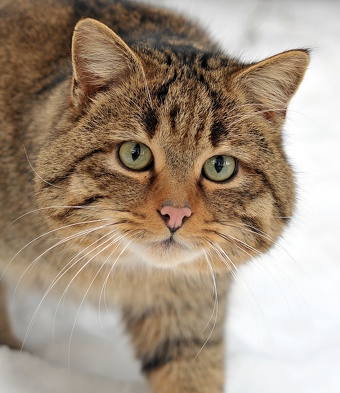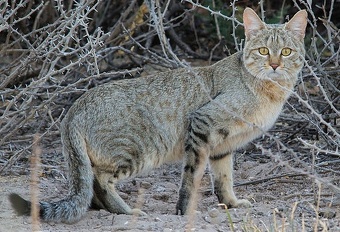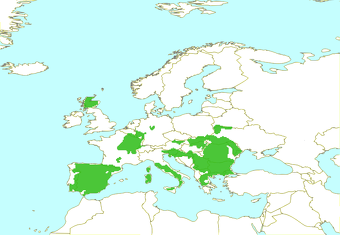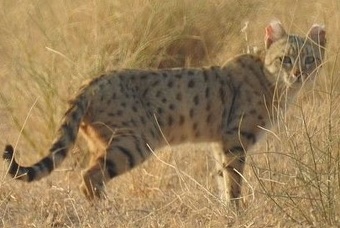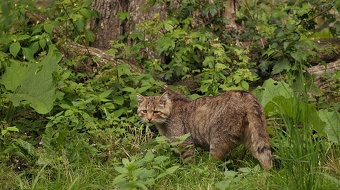Home | Category: Desert Animals
WILDCATS
Wildcats is the term used for a species complex comprising two small wild cat species: 1) European wildcats (Felis silvestris), which inhabits forests in Europe, Anatolia and the Caucasus; and 2) African wildcats (Felis lybica), which are found semi-arid landscapes and steppes in Africa, the Arabian Peninsula, Central Asia, into western India and western China. The two wildcat species differ in fur pattern, tail, and size: the European wildcat has long fur and a bushy tail with a rounded tip; the smaller African wildcat is more faintly striped, has short sandy-gray fur and a tapering tail;the Asiatic wildcat (F. lybica ornata) is spotted. [Source: Wikipedia]
Wild cat can refer to any wild cat. Here we use the term wildcat to refer to a specific group of small cats that are widely distributed and live in a variety of habitats. For a long time Felis silvestris was regarded as being made up of three, distinct groups (or subspecies): 1) F. silvestris lybica (African wildcats); 2) F. silvestris silvestris (European wildcats); and 3)F. silvestris ornata, (Asiatic wildcats). Now European wildcats (Felis silvestris, formerly F. silvestris silvestris) are recognized as a separate species, distinct from African wildcats (Felis lybica, formerly F. silvestris lybica); and Asiatic wildcats (F. lybica ornata, formerly F. silvestris ornata) are considered a subspecies of African wildcat. Domestic cats are thought to be descended from African wildcats.
Wildcats are similar in size to domestic cats but have longer legs. Their back fur is usually buff grey and their underside is pale ocher. They have bushy tails and a well-defined pattern of black stripes over their entire body. The fur is short and soft. Primarily nocturnal, they have reddish ears and black leg markings. Common and very fierce for their size, they eat rodents, birds and snakes, and give birth to up to four young. Their lifespan in the wild is as high as 15 years. Their lifespan in captivity is as a high as 30 years.
Most wildcats are preyed upon when they are young by larger predators, such as foxes, wolves, other cats, and large birds of prey, such as owls and hawks. Wildcats put up a fierce fight when threatened and can protect themselves from animals larger than themselves. They are also very quiet, secretive and agile. Wildcats play an important role in controlling populations of rodents and other small mammals. Domestic cats are still kept in many places largely to control rodent populations, especially in agricultural areas.
Wildcat Characteristics and Diet
Wildcats range in weight from 3.5 to five kilograms (7.7 to 11pounds). They have five toes on each of their forepaws, but only four toes on each back paw. Their claws can be drawn back into sheaths when not in use, keeping them quite sharp. The tongue is covered with tiny, curved projections called papillae that give the tongue a rough sandpaper-like texture. These are used for grooming and licking meat off bones. Although cats have whiskers, they lack eyelashes. They have a full inner eyelid, or nictitating membrane, which protects the eye from damage and drying. Sexual Dimorphism (differences between males and females) is present: Males are larger than females.[Source: Nicolle Birch Anna Toenjes, Animal Diversity Web (ADW) /=]
Cat teeth are highly specialized for eating meat. Their canines are excellent for stabbing and holding prey as the upper ones point almost straight down and the lower ones are curved. Molars are specialized for cutting. Since wildcats lack any teeth for crushing, they eat their food by slicing it.
Wildcats are primarily carnivores (eat meat or animal parts) and mostly eat terrestrial vertebrates such as small mammals, birds, reptiles, carrion, insects and terrestrial non-insect arthropods. They sometimes store or cache food. As is the case with most small cat species, the diet of wildcats is mainly made up of small rodents, such as mice and rats. Rabbits may be preferred prey in some areas. Other prey items include birds, young ungulates, reptiles, amphibians, eggs, and large insects and arachnids. European wildcats have been recorded scavenging carrion, but this is reported to be rare in African and Asiatic wildcats. Occasionally, cats eat grass in order to clear their stomach of indigestible food, like bones, fur, and feathers. Wildcats are able to subdue prey almost as large as themselves and tend to avoid prey that is spiny, has shells, or has an offensive odor. Female wildcats may teach their young how to capture prey by bringing them injured animals on which to practice.
Wildcats and Domestic Cats
Domesticated cats are direct descendants of African wilds. They resemble each other and have the same number of chromosomes. In ancient times African wildcats were common around human settlements and were easily tamed. Today, Domestic cats occur in many habitat types because of their association with humans. They do best in areas where winters are not severely cold. [Source: Nicolle Birch Anna Toenjes, Animal Diversity Web (ADW) /=]
Laura Geggel wrote in Live Science: Neolithic farmers in Anatolia (modern-day Turkey) domesticated cats about 10,000 years ago to keep vermin at bay. The earliest evidence of cat domestication is from Anatolia, but the ancient Egyptians also domesticated cats. It's unclear if Anatolia cats and the Egyptian cats are from the same, or different, lineages. Cats were so useful, farmers took them to Europe as far back as 4400 B.C., and the cats quickly spread as sailors and other rodent haters took them around the ancient world. [Source Laura Geggel, Live Science, June 21, 2017]
Domestic cats were probably attracted to the high rodent populations near human settlements and were welcomed as a way of controlling rodent populations. In many cases these rodents ate seeds and grass as their natural food and were attracted by growing and stored grain that became commonplace in areas where agriculture took hold thousands of years ago. There may have also been a religious origin to true domestication. An Egyptian cult centered in the ancient city of Bubastis worshiped cats. Followers of the goddess Bast, the goddess of pleasure, created sanctuaries with bronze statues of cats and mummified hundreds of thousands of cats.[Source: Tanya Dewey, Animal Diversity Web (ADW)
According to the Washington Post: “Cats probably started living close to humans when people evolved from nomadic herding to raising livestock and crops and started storing food, which attracted mice and other rodents. Cats found good hunting there, and humans surely appreciated the sly little predators' help protecting their stocks. "There was a mutual benefit," Lyons said. "There was a food source of mice and rats all around the grain. So it was beneficial for both cats and humans as the cats came closer to human populations and kind of domesticated themselves." From there, domesticated cats started to radiate out to different parts of the world, often following humans on their migrations. Today cats can be divided genetically into four broad groups: those from Europe, the Mediterranean, East Africa and Asia. [Source: Rob Stein, Washington Post, March 17, 2008]
European Wildcats
European wildcats (Felis silvestris) inhabits forests in Europe, Anatolia and the Caucasus. They have long fur and a bushy tail with a rounded black tip. Their fur is brownish to grey with stripes on the forehead and on the sides. Their coloration is similar to that of tabby domestic cats, which makes them difficult to see in their forested habitats. They have a head-to-body length that reached up to 65 centimeters (26 inches) with a 34.5-centimeter (13.6-inch) -long tail, and weighs up to 7.5 centimeters (17 pounds). European wildcats have thick, winter fur, which sometimes makes them look larger than other wildcats. [Source: Wikipedia]
European wildcats are a species separate from African and Asiatic wildcats, which together belong to a different species. European wildcats are found throughout Europe and western Russia, except for much of the British Isles (they are found in Scotland though) and Scandinavian countries. They are found primarily in deciduous forests but are also known, to a lesser degree, to inhabit coniferous forests. They are restricted in their northern range by snow depth and are typically found in areas of low human populations. European wildcats cannot survive in areas where snow depth in the winter is more than 20 centimeters (8 inches) deep for more than 100 days. They have been observed in human-dominated landscapes where grazing is the main form of agriculture, scrublands, riparian environments (wetlands adjacent to rivers) and coastal areas. [Source: Tanya Dewey, Animal Diversity Web (ADW)
In France and Italy, European wildcats are predominantly nocturnal, but also active in the daytime when undisturbed by human activities. They prey mainly on small mammals such as lagomorphs (rabbit and hares) and rodents, but also on ground-dwelling birds. Rabbits may be dominant prey for European wildcats. Food caching has been reported by them.
African Wildcats
African wildcats (Felis lybica) are found in semi-arid landscapes and steppes throughout Africa, the Arabian Peninsula and Central Asia as far east as western India and China. They are smaller than European wildcats and are more faintly striped, has short sandy-gray fur and a tapering tail; [Source: Wikipedia]
African wildcats occur in a wide variety of habitats including deserts, savannas, shrublands and grasslands. In Africa they are absent only from tropical rainforest areas. In desert regions they are mainly restricted to mountainous areas and waterways.

range of African and Asiatic wildcats: Northern African wildcats (red); African wildcats (blue); Asiatic wildcats (green)
African wildcats are the ancestors of domestic cats (F. catus). Some African wildcats were domesticated about 10,000 years ago in the Near East. They were present in the first towns more than 7,000 years ago and were domesticated in Egypt about 4,400 years ago and began to be introduced outside of that area on a relatively large scale about 2,000 years ago.[Source: Tanya Dewey, Animal Diversity Web (ADW) /=]
African wildcats weigh four to five kilograms (8.8 to 11 pounds) and have a head and body length of 50 to 75 centimeters (1.6 to 2.5 feet), with 21-to-35 centimeter (8.3-to-13.7-inch) tail. Domestic cats are similar in size, but can become much heavier as a result of over-feeding.
African wildcats are difficult to distinguish from domestic cats. Their fur is lighter and less dense than European wildcats, and their tails are thin and tapering. African wildcats span a large geographic range, though, and coat coloration and density varies with latitude, ranging from sandy yellow to gray and brown, with darker stripes and spots. They have a characteristic reddish tint to the fur on the backs of their ears. /=\
Asiatic Wildcats
Asiatic wildcats (Felis lybica ornata) are a subspecies of African wildcats. Also known as Indian desert cats, they are often spotted and found in Europe, southern Russia, the Middle East, including Iraq, Iran, Saudi Arabia, parts of Africa and Central Asia, including Afghanistan, Pakistan, western China, and western India. Asiatic wildcats are most commonly associated with the region from the eastern Caspian Sea north to Kazakhstan, into western India, western China and southern Mongolia.
Asiatic wildcats wildcats weigh 2.7 to four kilograms (6 to 8.8 pounds) and have a head and body length of 50 to 75 centimeters (1.6 to 2.5 feet), with 21-to-35 centimeter (8.3-to-13.7-inch) tail. They tend to have a background fur color that is more reddish or yellow, with an overlying pattern of dark spots that sometimes converges into stripes.
Asiatic wildcats are found primarily in scrub desert, but can be found in a wide variety of habitats. They are absent from alpine and steppe grasslands and the northern limit of their distribution may be determined by snow depth. They can be found up to 3000 meters in mountains and are usually found in areas near water sources. Rodents preyed on by Asiatic wildcats include jerboas, gerbils, voles, and mice.
Wildcat Taxonomy and Subspecies
There are a number of subspecies of wildcat. At least 14 subspecies of European wildcats have been recognized. The African wildcat and Arabian desert cat are close relatives as are their subspecies. Most wildcats subspecies have interbred at least somewhat with domesticated cats. The Arabian desert cat is one of the most endangered subspecies of wildcat, due primarily to interbreeding with domestic cats. A captive breeding program for them was set in Abu Dhabi.
In the 1940s, taxonomist Reginald Innes Pocock reviewed the collection of wildcat skins and skulls in the Natural History Museum, London, and designated seven European wildcat subspecies from Europe to Asia Minor, and 25 African wildcat subspecies from Africa, the Middle East and Central Asia. Pocock categorized them in three main groups: 1) Forest wildcat subspecies (silvestris group); 2) Steppe wildcat subspecies (ornata-caudata group), distinguished from the forest wildcat by being smaller and having lighter fur color, and longer and more sharply-pointed tails (domestic cats are thought to have derived from this group); and 3) Bush wildcat subspecies (ornata-lybica group), distinguished from steppe wildcat by even paler fur, and well-developed spot patterns and bands. In 2005, 22 subspecies were recognized in “Mammal Species of the World”, who defined subspecies largely in line with Pocock's assessment.[Source: Wikipedia
In 2017, the Cat Classification Task Force revised the taxonomy of the Felidae, and recognized the following as valid taxa: A) European wildcats (F. silvestris) Schreber (1777) have dark grey fur with distinct transverse stripes on the sides and a bushy tail with a rounded black tip. Subspecies: F. s. ferus Erxleben (1777); obscura Desmarest (1820); hybrida Fischer (1829); ferox Martorelli (1896); morea Trouessart (1904); grampia Miller (1907); tartessia Miller (1907); molisana Altobello (1921); reyi Lavauden (1929); jordansi Schwarz (1930); euxina Pocock (1943); cretensis Haltenorth (1953).
B) Caucasian wildcats (F. s. caucasica) Satunin (1905) have light grey fur with well developed patterns on the head and back and faint transverse bands and spots on the sides. The tail has three distinct black transverse rings. Subspecies: trapezia Blackler (1916)
C) African wildcats (F. lybica) Forster (1780); has pale, buffish or light-greyish fur with a tinge of red on the dorsal band; the length of its pointed tail is about two-thirds of the head to body size. Subspecies: F. l. ocreata Gmelin (1791); nubiensis Kerr (1792); maniculata Temminck (1824); mellandi Schwann (1904); rubida Schwann (1904); ugandae Schwann (1904); mauritana Cabrera (1906); nandae Heller (1913); taitae Heller (1913); nesterovi Birula (1916); iraki Cheesman (1921); hausa Thomas and Hinton (1921); griselda Thomas (1926); brockmani Pocock (1944); foxi Pocock (1944); pyrrhus Pocock (1944); gordoni Harrison (1968)
D) Southern African wildcats (F. l. cafra) Desmarest (1822) do not not differ so much in fur colour and pattern from African wildcats. Based on available zoological specimens they have slightly longer skulls than those from farther north in Africa. Subspecies: F. l. xanthella Thomas (1926); vernayi Roberts (1932)
E) Asiatic wildcats (F. l. ornata) Gray (1830) have dark spots on light, reddish-grey colored fur. Subspecies: syriaca Tristram (1867); caudata Gray (1874); maniculata Yerbury and Thomas (1895); kozlovi Satunin (1905); matschiei Zukowsky (1914); griseoflava Zukowsky (1915); longipilis Zukowsky (1915); macrothrix Zukowsky (1915); murgabensis Zukowsky (1915); schnitnikovi Birula (1915); issikulensis Ognev (1930); tristrami Pocock (1944)
Wildcat Behavior
Wildcats are scansorial (able to or good at climbing), terricolous (live on the ground), nocturnal (active at night), motile (move around as opposed to being stationary), sedentary (remain in the same area) and solitary. Male wildcats have home ranges that overlap with the ranges of several females. A male African wildcat was recorded as having a home range of 4.3 square kilometers. The home ranges of domestic cats varies widely with the concentration of resources and the density of restrained versus feral cats. [Source: Nicolle Birch Anna Toenjes, Animal Diversity Web (ADW) /=]
According to Animal Diversity Web: Wildcats and their domestic counterparts are usually active at night or at dusk and dawn, although they are also active during the day, particularly in areas with little human disturbance. Asiatic wildcats in particular are often active during the day. Wildcats often travel widely at night in search prey. One European wildcat was recorded traveling 10 kilometers in a night. /=\
Wild cats are primarily solitary animals, their domestic counterparts are more social and can occur in small family groups. Feral domestic cats are also usually solitary, but may form small colonies in areas where food sources are clustered, such as garbage dumps. In unrestrained domestic cat populations, female cats typically stay in their area of birth while males leave their area of birth and attempt to establish a home range elsewhere. In areas with concentrations of free-ranging domestic cats a sort of hierarchy is formed. Newcomers must go through a series of fights with resident animals before their position in the hierarchy is established. /=\
Wildcat Senses and Communication
Wildcats sense and communicate with vision, touch, sound and chemicals usually detected by smelling. They have well developed senses of smell and hearing. The ears of a cat can rotate rapidly to identify the source of sounds and are able to respond to frequencies up to 25,000 vibrations per second. Because of this ability, cats can hear even ultrasonic noises made by small rodents. This sometimes allows them to locate and capture prey without seeing it. Cats can also sense using their whiskers, or vibrissae. Whiskers are special hairs that are used as highly sensitive touch organs. A cat uses its whiskers to determine if their bodies can fit through small openings such as small pipes, and other various objects. They also use them to detect the movement of prey. [Source: Nicolle Birch Anna Toenjes, Animal Diversity Web (ADW) /=]
The sight of cats is probably not better than that of humans. The range of colors seen by cats are smaller than the human range. The eyes of cats are located on the front of the head. Although this allows them to have excellent depth perception, a useful tool in hunting, cats cannot see directly under their noses. They also have the ability to see even tiny movements, helping them to locate prey. Their eyes are adapted for vision in dim light for hunting just after dusk or before dawn. /=\
Wildcats leave scent marks produced by special glands and placed so others can smell and taste them. Males mark territories by spraying strong urine on objects throughout their home ranges. Females communicate when they are ready to breed with scents that they emit which are highly attractive to males. Cats have scent glands on their foreheads, around their mouths, and near the bases of their tails. A cat rubs these glands against objects to mark them with its scent.
Wildcats communicate with visual cues, such as raising the hair on their backs, moving their tails, and facial expressions. They also have a variety of sounds that communicate different intents, including aggressive hisses and yowls, affectionate purring, and a 'be quiet' squeak used to silence kittens. /=\
Wildcat Mating, Reproduction and Offspring
Wildcats are polygynous (males have more than one female as a mate at one time). They engage in seasonal breeding. European wildcats give birth to one litter each year. Sometimes they may give birth to a second litter if the first was lost early in the season. The gestation period ranges from 60 to 70 days, with the average being 66 days. The number of offspring ranges from one to eight, with the average number being between three and four. Domestic cats may breed much more frequently, as often as three times a year, as they are not typically limited by nutrition or climate. Average litter size in domestic cats are four to six. The gestation period averages 65 days.[Source: Nicolle Birch Anna Toenjes, Animal Diversity Web (ADW) /=]
When a female wildcat goes into estrus, local males congregate near the female and compete for access to her. Males screech, yowl, display, and fight. Females mate with multiple males and multiple paternity in single litters is possible.
Breeding in wildcats occurs at different times of the year, depending on local climate. Among European wildcats breeding occurs in late winter (January to March) and births occur in the spring, usually in May. Breeding has been recorded nearly year round in Asiatic wildcats and, in African wildcats breeding has been recorded from September through March.
Wildcat Offspring and Parenting
For European wildcats births occur usually in May. Females give birth in a protected burrow, often a space under rocks or in dense vegetation. Young are altricial, meaning they are relatively underdeveloped at birth. The age in which young are weaned ranges from 42 to 84 days. One source says females and males reach sexual or reproductive maturity at 9 to 12 months. Another says females become sexually mature at about 10 to 11 months old, and males do do from nine to 22 months. Domestic females become sexually mature as early as six months old.
Young are born with their eyes closed and are unable to walk. They are nursed and cared for in the den by their mother. Their eyes open at 10 days old and they nurse for about 30 days. They remain with their mother, learning hunting and survival skills for from four to 10 months, usually around five months. After that they are driven from their mother's range and must become independent. Males do not help to care for kittens. Domestic kittens are weaned at about eight weeks old and become independent at about six months old.
Wildcats, Humans and Conservation
On the International Union for Conservation of Nature (IUCN) Red List both European and African wildcats are listed as a species of Least Concern. In CITES (Convention on International Trade in Endangered Species of Wild) they have no special status. [Source: Nicolle Birch Anna Toenjes, Animal Diversity Web (ADW) /=]
European wildcats are critically endangered in some parts of their native range. They were largely exterminated from western and central Europe during the 19th and 20th centuries because they were considered a danger to game and domestic animals. They continue to be threatened by habitat loss, but populations are making a recovery in many parts of their former range. Other threats to European wildcats include population isolation, deaths from being hit by automobiles, and vulnerability to diseases transmitted by domestic cats. They are currently protected throughout Europe and several re-introduction efforts are underway. /=\
The main threat to all wildcat populations, especially those of European wildcats, is continuing hybridization (inter-breeding) with domestic forms. Hybridization results in decreased genetic purity of the wild forms. Some researchers suggest that genetically pure European wildcats are extinct as a result of extensive hybridization. /=\
Image Sources: Wikimedia Commons
Text Sources: Animal Diversity Web animaldiversity.org ; National Geographic, Live Science, Natural History magazine, CNTO (China National Tourism Administration) David Attenborough books, New York Times, Washington Post, Los Angeles Times, Smithsonian magazine, Discover magazine, The New Yorker, Time, BBC, CNN, Reuters, Associated Press, AFP, Lonely Planet Guides, Wikipedia, The Guardian, Top Secret Animal Attack Files website and various books and other publications.
Last updated May 2025

